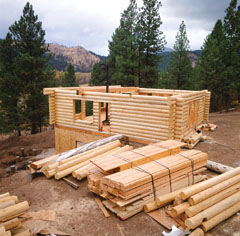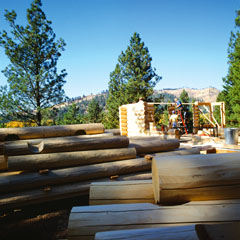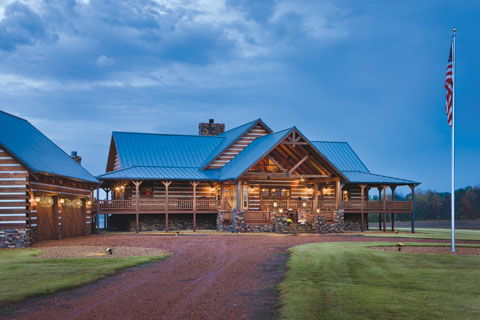Imagine you’re going to the supermarket, and apples are on your shopping list. You love apples and you can’t wait to buy them so you can sink your teeth into one. But when you get to the store, you’re faced with choices. Gala apples are on sale for less than the Fuji variety, but when you compare the two, the latter seem to be fresher, making the Gala seem like less of a deal. Then you spy the Honey Crisp—the most expensive, but also the sweetest, biggest fruit on the shelf. And they are your favorite.
You’ve got some decisions to make. You have to compare all the options and evaluate which one will satisfy both your tastes and your budget.
Welcome to the world of log home package comparisons.
A package is a great way to buy a log home. But log home packages are not consistent from manufacturer to manufacturer. In fact, to satisfy a variety of customer needs, some log home producers even offer varying package levels within their own organization.
For example, a basic package may simply provide the logs, floor joists, and roof trusses, presenting buyers with a low price and enabling them to purchase the rest of the home’s materials on their own. Other, more inclusive packages may also supply the windows, roofing materials, interior drywall, etc. This type of package will cost more, but you can be certain that the logs were milled to precisely to work with these other products.

Rocky Mountain Log Homes
According to Mark Elliot, vice president of New Hampshire-based Coventry Log Homes, that’s one of the biggest advantages of going with a package. “Every cut, every notch has a purpose in a precut package,” he says. “Precision equipment like the machines we use in the mill can’t be lugged to a job site. A precut home will be much more structurally sound than one cut onsite. The alternative is the same thing as Home Depot delivering a bunch of 2x4s to your lot and saying, ‘Here’s your package.’”
Mark advises log home buyers not to be lured in by companies that offer “packages” at ridiculous discounts. Most often, they are not packages at all, but timbers that are not precut or properly graded for accurate placement in the home. “Forget about the old adage of making sure you compare ‘apples to apples,’” he says. “This is like comparing apples to lettuce.”
As a buyer, one of the most difficult aspects to ensuring you’re getting the best package for the money is becoming familiar with the lingo of construction. Jock Davidson, director of sales and marketing for Daniel Boone Log Homes in Nashville, Tennessee, says asking a lot of questions is the key to knowing exactly what each package contains and comparing them properly. “Don’t assume because you see the phrase ‘roof system’ on your material list that you’re getting a roof,” he cautions. “To one manufacturer, ’roof system’ may mean everything including shingles; to another, it may mean merely the trusses and you—the buyer—is responsible for the rest. Ask a lot of questions.”
Elliot says one of the best questions a comparison shopper can ask is one of the simplest. “As you’re talking with your sales rep from each manufacturer you’re considering ask, ‘What’s missing from your package, and what else do I have to buy to make it complete?’ The answer to this two-part question will give you a true idea as to how complete a log home producer’s package really is.”
Davidson says a lot of the guesswork can be significantly reduced if you deal with a reputable company. What are the hallmarks? According to Davidson, look for the number of years they’ve been in business; a solid track record of satisfied customers; testimonials (get references and check them!); and clean records with their Chamber of Commerce, Better Business Bureau, and State Attorneys General office.
“Checking all these sources can seem like a lot of work, but for a purchase of this magnitude, it pays to do your research,” Davidson says. Like Elliot, he believes a reputable company will provide you with a list of materials that are not included.

Rocky Mountain Log Homes
Davidson says that a good company also will know what you need to meet code—or ask the right questions to figure it out. However, keep in mind that log home manufacturers ship their packages all over the country, even internationally, and cannot possibly know the building codes for every region.
This is where communication between you and your sales rep is so vital. Give each manufacturer you’re exploring as much information about your area as possible, and, so you can compare them accurately, make sure they all have the same information to work with. “Snow load, wind load and seismic tendencies are all factors that can impact the price of a package,” Davidson says. “Giving the manufacturer a complete picture may increase the package quote upfront, but that’s far better than being surprised by changes and upcharges well into the construction process.” A permitting officer for your county or municipality should be able to give you the code requirements for your area.
So what are the red flags that a manufacturer is not reputable? According to Davidson, there are two major alarms: (1) Pressure to buy too quickly—this is a major decision and you should be given the opportunity to weigh all your options, not worry about a deal that will expire if you don’t “act now.” (2) Discounts that are too deep—as the saying goes, if it seems too good to be true, it probably is.
In the end, whether deciding between manufacturers or package levels from manufacturers, most log home buyers choose a complete package. Not only does this option provide the most hassle-free buying experience, manufacturers have buying power with suppliers that enable them to get materials, such as windows and roofing, for far less than average consumers can get on their own. They know exactly what the buyer needs and how much.
Plus, getting the entire home from one source is more than just convenient. “There’s peace of mind in knowing that everything was engineered to work together,” says Elliot.

